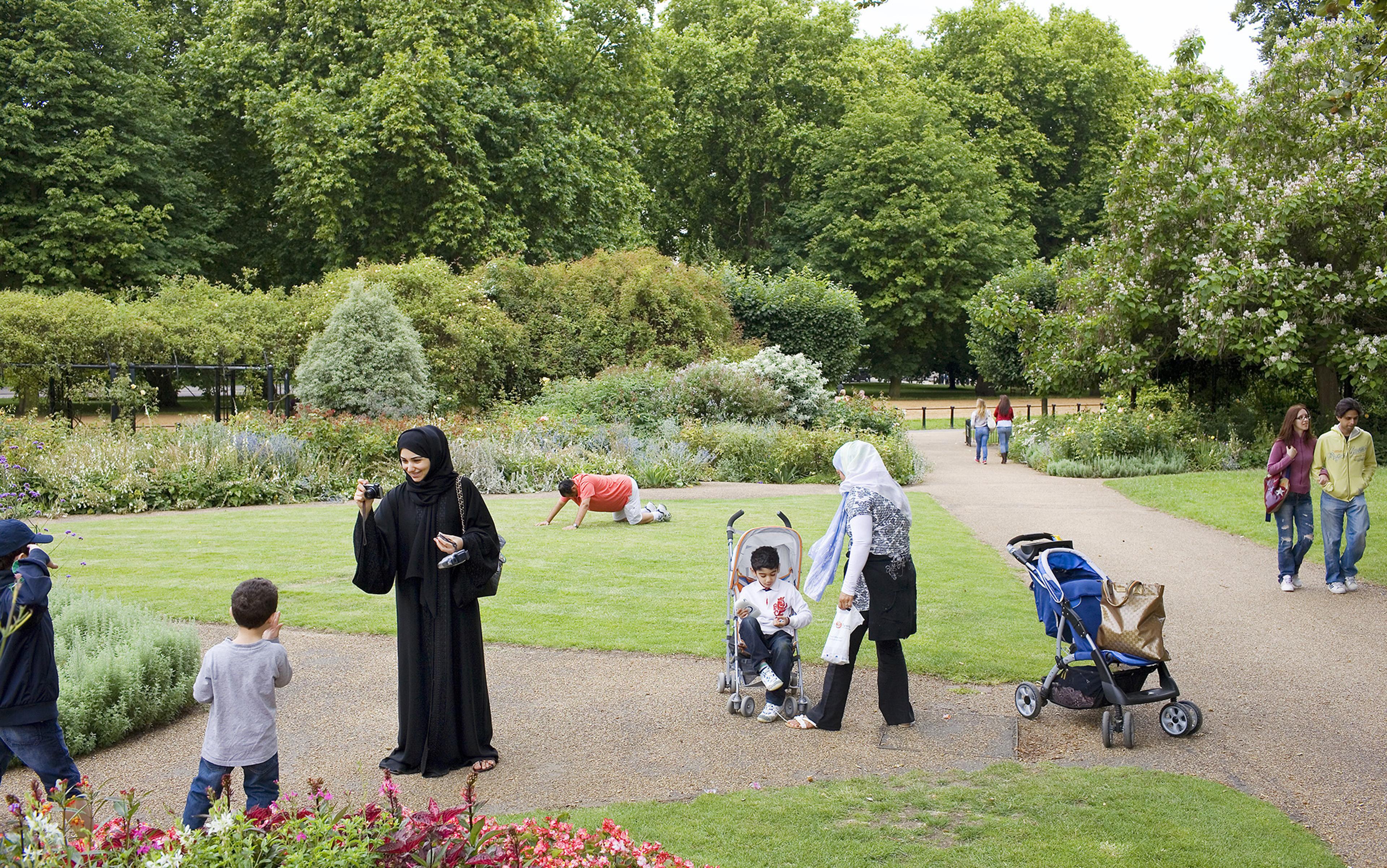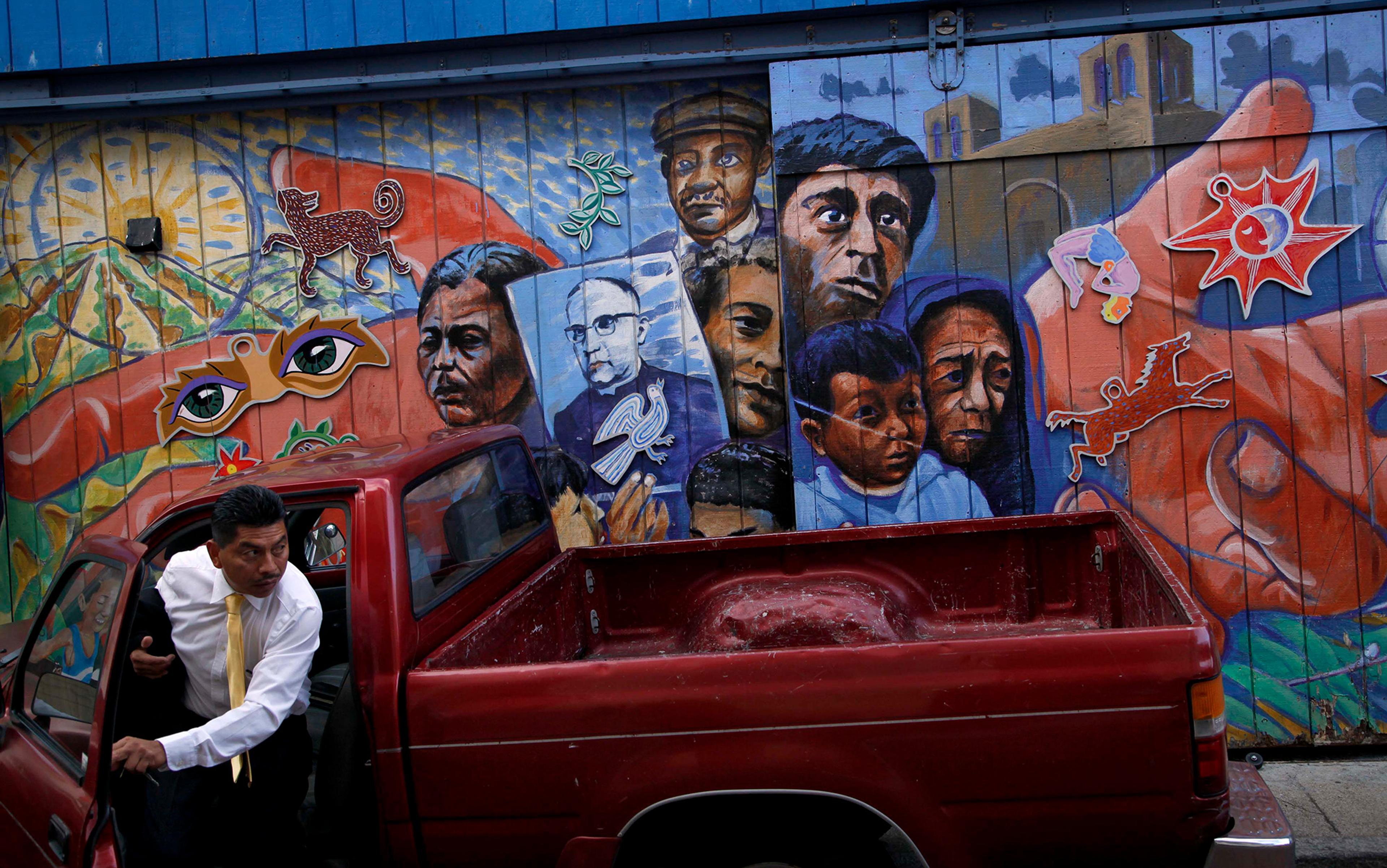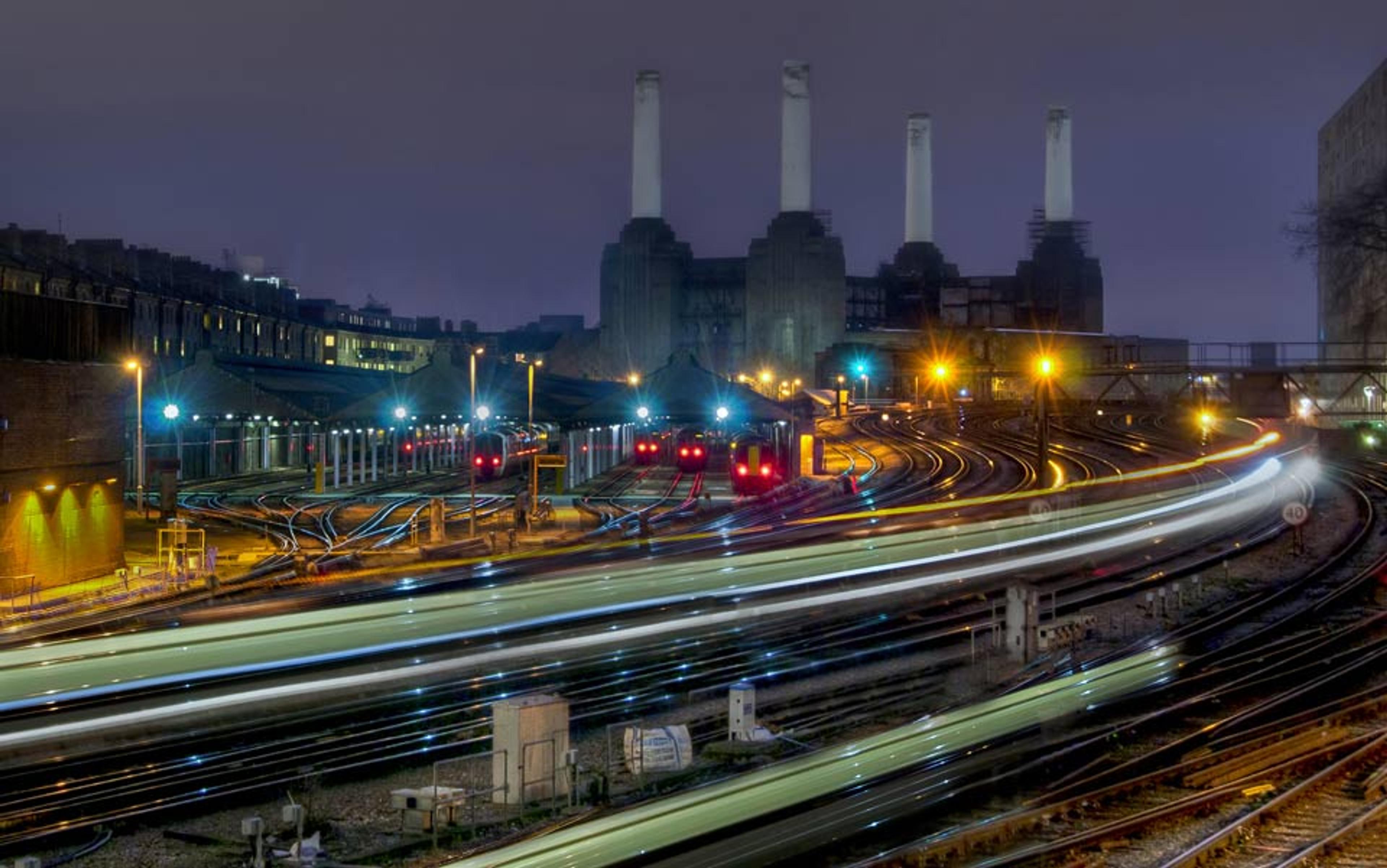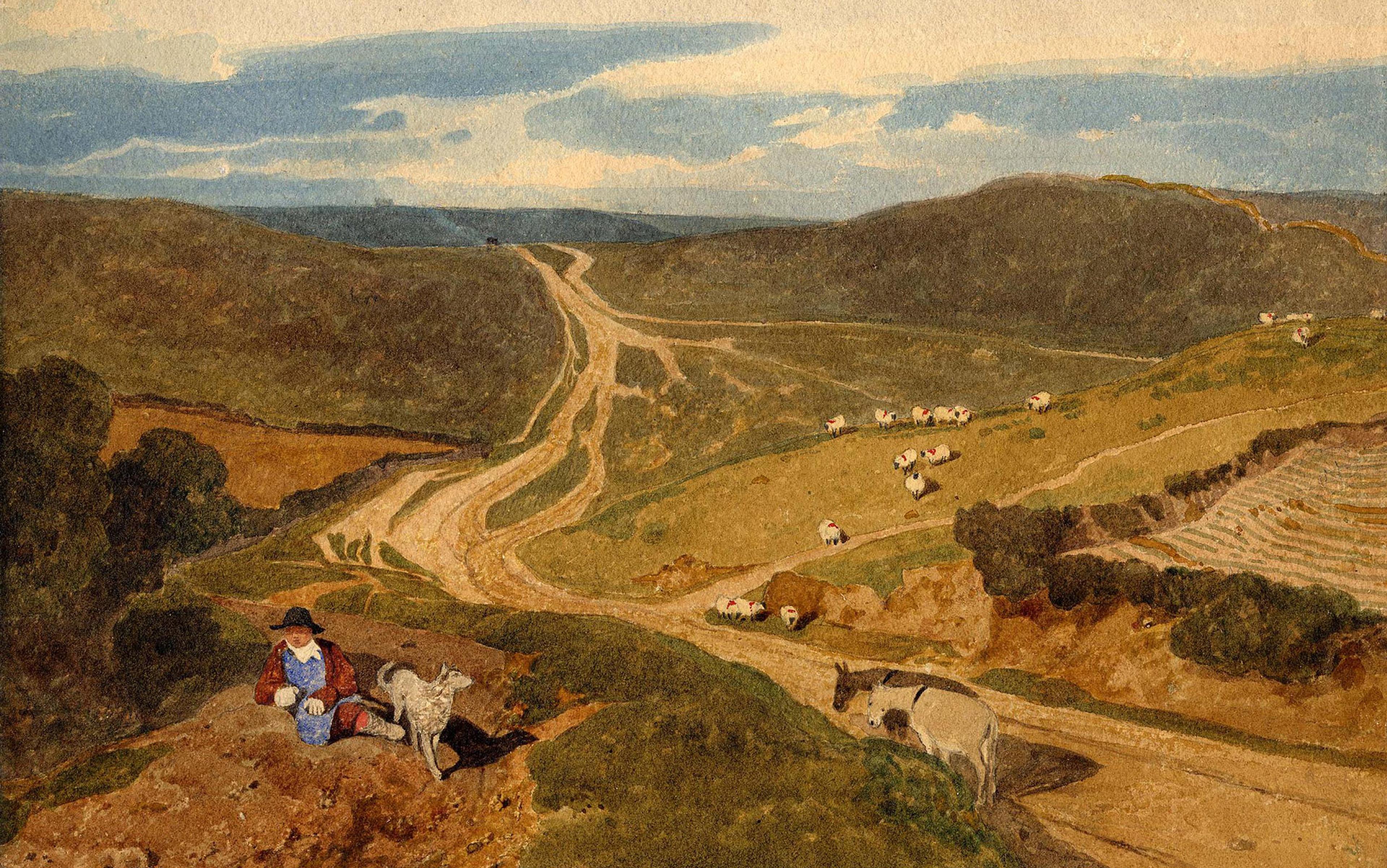Depending on whom you ask, Kilburn is either one of the most vibrant or one of the most dysfunctional neighbourhoods in London. Clustered in the north-western part of the city, the area has been a swirling mix of cultures for more than 100 years, starting with Irish and Jewish migrants in the late 19th and early 20th century, up to more recent arrivals from the Caribbean, Latin America, Sub-Saharan Africa and eastern Europe. Walk along the Kilburn High Road today, and you’ll likely hear the cries of imams and evangelical preachers, threaded through with the rhythmic beats of reggae and a hodgepodge of accents, as people duck into takeaway food shops, hurry to meet friends, or pick up household items from eclectic corner stores catering to tastes from all corners of the globe.
Kilburn was my home for 16 months between 2014 and 2016. I’m a social anthropologist who investigates how people build communities in diverse areas, so I tried to trace the tangle of life on Kilburn’s streets by talking to the people I encountered in its estates, community centres and cafes. The writer Zadie Smith grew up here, and her fiction was a stimulus and guide. The Kilburn she depicts is not a harmonious whole but a jumble of different, uncontainable worlds. As she puts it in the novel NW (2012):
Low-down dirty shopping arcade to mansion flats to an Englishman’s home is his castle. Open-top, soft-top, drive-by, hip hop. Watch the money pile up. Holla! Security lights, security gates, security walls, security trees, Tudor, modernist, post-war, pre-war, stone pineapples, stone lions, stone eagles. Face east and dream of Regent’s Park, of St John’s Wood. The Arabs, the Israelis, the Russians, the Americans… Free meals. English as a second language. Here is the school where they stabbed the headmaster. Here is the Islamic Centre of England opposite the Queen’s Arms. Walk down the middle of this, you referee, you!
When Kilburn’s residents do come together in public, clashes often ensue. Given the diverse needs, wants and lifestyles of local people, this isn’t really surprising; conflicts over the commons are a persistent feature of urban life, after all. But in recent decades this sort of friction has coincided with a sharp decline in the amount of shared space available in cities all around the world. Libraries are closing in the UK; the grand squares and historic boulevards of post-communist countries are being privatised; and in India, parks and roads are routinely sold off to developers. In the United States, the erosion of public spaces began with the post-war flight to the suburbs, and the more recent rediscovery of the inner city by the young and affluent has done little to halt the general trend.
Governments, justifying the sale of public land, claim that people are leading increasingly private lives, and relying less and less on shared resources. Meanwhile architects and urbanists shout ever more loudly about the value of shared space. They point to research that shows it fuels growth and innovation, enhances health and wellbeing, and allows people to get to know strangers and become familiar with diverse others. ‘By its nature, the metropolis provides what otherwise could be given only by travelling; namely, the strange,’ wrote the pioneering urbanist Jane Jacobs in 1961. It’s almost like two parallel conversations have been happening at once: one in which shared space is the lifeblood of the city, and another where it is treated as residual, fractious and a source of financial liability.
Some activists think that the solution lies in design: we just need to construct and reconstruct our cities to make them more inclusive, attractive, flexible, better suited to people’s needs. That’s the motivation behind many urban regeneration projects, from New York’s High Line to the Guggenheim Museum in Bilbao, Spain. These initiatives can be more or less successful, but my research in Kilburn makes me think that the problem with public space runs much deeper. It’s not our architecture that needs a refresh, but our habits. Deep down we don’t truly value public space, because we’ve been conditioned to think it should be given to us, as of right – instead of forged through encounters, interactions and, crucially, negotiations.
The public realm is full of confrontations. On Kilburn’s council estates, residents cast dark glances at groups of young men who gather to drink, talk and listen to music. Parks get commandeered for barbecues and seniors’ exercise groups, for football matches, family gatherings and groups of friends, and each of these groups might compete for priority. The streets bustle with pedestrians, rolling their eyes as they dodge mothers pausing for a chat over their prams, or are forced to sidestep the overzealous street vendors hawking batteries, flowers, handbags. Some locals claim that the restrictions on noise levels at a public hall are stifling local gatherings, while other people continue to complain about… the noise.
Within each of these encounters is a tug of war between different ways of thinking, not only about public space, but what it means to be a citizen. In a liberal political order, the paradigm of ‘rights’ tends to prevail. From the French Revolution to the American Declaration of Independence, the history of democracy can be read as a story of the expansion of the state-guaranteed entitlements and privileges that accrue to individuals. As a consequence, we’ve shifted away from understanding the citizen as a node in a social hierarchy, to relying on the idea of a free person, defined by a universally shared set of rights.
Urbanists have deployed this thinking to call for what’s known as the ‘right to the city’. The French philosopher Henri Lefebvre first coined the term in 1968, and it’s since been championed by activists, thinkers and organisations from UNSECO to the Occupy movement. The Marxist theorist David Harvey summarises it like this, in his book Rebel Cities (2012):
[T]he question of what kind of city we want cannot be divorced from the question of what kind of people we want to be, what kinds of social relations we seek, what relations to nature we cherish, what style of daily life we desire, what kinds of technologies we deem appropriate, what aesthetic values we hold. The right to the city is, therefore, far more than a right of individual or group access to the resources that the city embodies: it is a right to change and reinvent the city more after our heart’s desire.
The idea is that we all need access to public goods to live worthwhile lives – whether that’s parks in which to exercise, pipes to bring us water and take away waste, or libraries and museums to expand our horizons. Each of us, however, places different demands on these amenities. The elderly and handicapped might require special provisions from public transport; installing better street lighting might matter especially to women who walk home alone; activists are in need of spaces to gather and protest. To accommodate these diverse and changing needs, people have a right not only to access public amenities but to transform them in line with what they require. In other words, for right-to-the-city thinkers, the ideal urban environment should be constantly re-made by and for citizens.
The struggle for more inclusive city spaces is part of this story. Central Park in New York City, built in the mid-1800s, was designed to provide a space for the benefit of rich and poor alike in an otherwise crowded and unequal city. In London in the 1980s, feminist urbanists formed the Women’s Design Service to provide free planning expertise to communities targeted by property speculators and ‘regeneration’ schemes. In Vienna in the 1990s and 2000s, the city council began to take account of the distinct ways in which older people and families with children used public spaces – and so widened its sidewalks for strollers, increased street lighting, and built more accessible crossings and steps. In almost every city in the world, you can find a collection of such campaigns, big and small, invoking the language of rights and touching on everything from trash collection to walkable streets, from boosting local retailers to securing green space.
But some dilemmas of city life can’t be solved through careful planning. In Kilburn, the presence of young people in the public areas of council estates often drives other residents away. No matter the quality of the space, or the thought or investment that had gone into it, some Kilburners I interviewed have come to think of certain squares and parks as places of danger and degradation. The sounds of blaring hip hop and grime, of shouting, the stares that follow passing strangers, and the spectacle of discarded bottles and raised hoods evoked, for many, the area’s bloody history of gang violence. The whole set-up gave some residents the impression that such places were to be avoided.
Often they were right: spend enough time talking to kids hanging out around the estates, and it becomes clear that staking an assertive claim to public space is important to them – it helps them regain some sense of power and control. School was chaotic, their parents hardly cared, and the police treated you like a criminal before you could even ride a bike. Between the despondent teachers telling you not to expect much from the future, and rich newcomers moving into the area, it was reassuring to feel that something belonged to you.
Worshippers have a ‘right’ to spaces for celebration, but dog walkers have a ‘right’ to walk their dogs
Kilburn Grange Park was another site of conflict. Every year, a few hundred people gather to celebrate Eid al Fitr, the Muslim celebration marking the end of the month of fasting during Ramadan. Men in polos and T-shirts chat with others in flowing kurtas and thobes; women catch up with their neighbours and friends as children race underfoot, anxious to nab a sweet or have a turn on the bouncy castle and slides. The park provides a space for the large community to gather, on a day where few other venues could accommodate them. But other residents complain that the Eid revellers crowd out other locals and more or less privatise a public park. They’re made to feel unwelcome, they say. Meanwhile, worshippers are wary around the residents’ dogs, which threaten the state of ritual cleanliness known as wudu required for prayer. Watching these nervous responses, residents have come to speculate that women or even all non-Muslims might end up being barred. There’s always a story – someone knows someone who, a year or so ago, was prevented from entering the park for this or that reason.
Such clashes leave us at an impasse when thinking in terms of rights. Both conflicting parties can make reasonable arguments as to why accessing the space matters to them. Yet their entitlements end up being mutually exclusive, grounded in ‘equal’ rights, with neither party under any obligation to suspend their own interests for the sake of the other. Worshippers have a ‘right’ to spaces for prayer and celebration, but dog walkers have a ‘right’ to walk their dogs. We all share a right to parks or playgrounds or whatever other spaces are deemed public.
With no way to make a wholly fair judgment as to whose right trumps whose, competing claims over public space often turn into a shouting match. Those with the most dominant presence win, and the rest skulk off. Young men blast music and stare down passersby in parks; cops are enlisted to move the homeless from their shelters under bus stops or awnings. Annoyed residents petition against the noise from mosques, or from church bells or community centres, while those of us who feel excluded or abandoned seek out our own private spaces in response – moving into homogenous neighbourhoods, foregoing the park for the café, or retreating into the closed social circles and fantasy spaces of the online world. In short, when we look at public resources as things that exist simply to secure rights, they end up just being a second-rate substitute for private ones.
But there’s another way to think about the urban commons – not in terms of rights, but in terms of trust. In her book The Human Condition (1958 ), the philosopher Hannah Arendt suggested that contestation should not be avoided, but carefully embraced as a tool for generating consensus. ‘To be political, to live in a polis, meant that everything was decided through words and persuasion, and not through force and violence,’ she writes of the Ancient Greek city-state. Each political situation, she claims, has multiple possible resolutions. But the most just is the one that takes account of the widest range of views. To make this happen, people must be willing to make themselves known to each other, in public – they must be willing to expose their lives and fears and values, and engage in the difficult business of trying to understand the other’s perspective. ‘Being seen and being heard by others derive their significance from the fact that everybody sees and hears from a different position,’ Arendt claimed. As a result, we come to understand the plurality of the world, and we can attune our thinking to this plurality.
The difficulty with Arendt’s model of public life is that it requires the suppression of self-gratification: it involves thinking that no one has a default right to public space, but that public space becomes usable only when we find ways to work with others. This takes practice, in at least two senses. For one, it requires us to become familiar with communicating across difference – learning the language and the subtle physical cues that signal straight away that we are on the same side. On the other hand, it requires a belief that others will also make a similar effort to understand and accommodate us. This belief becomes more solid over time, as we accumulate more and more evidence that mutual accommodations are, in fact, possible. But initially it involves a gamble. Both these acts, then, require trust – trust that it is possible to learn to understand others, and trust that they will try to understand us.
Some Kilburn residents already embody this ideal. Nancy (not her real name) has been a Kilburner for most of her life. Born to Irish and English parents, she has white hair and sharp, blue eyes that are quick to scowl, and quicker still to laugh. Since her retirement, Nancy has become involved in several local community organisations. Listening to her neighbours’ wariness about using the park during Eid, Nancy had a different theory. She suspected the locals weren’t being excluded so much as excluding themselves – presuming prejudice and hostility before they even encountered it. To make her point, she decided to go to the celebrations with her fluffy Bichon Frise, Simba, in tow, to test out the reception she received.
Rather than presuming hostility, Nancy continued as if she were welcome, and she was welcomed warmly in return
A few days later, I visited Nancy at her flat. She was beaming from her success. The revellers had welcomed her warmly; they complimented Simba; she chatted to them about their colourful dresses and stylish hijabs. Nancy wasn’t really surprised: her experience of Kilburn has taught her that there was almost always something worth discovering about most people and places. To her, living in Kilburn meant: ‘We don’t avoid, we embrace!’
The Eid celebrants, for their part, held back their judgment in order to include Nancy. Rather than confronting her as a potential threat of uncleanliness, they trusted Nancy to control her dog, and they found her to be thoughtful and careful. And rather than presuming hostility, Nancy continued as if she were welcome, and she was welcomed warmly in return. What started out as two mutually exclusive uses of a park became inclusive, because each party accommodated the other without giving up what was most important to them about being there.
Such acts of trust could also transform the ‘problem’ of young people acting in an intimidating way in public. Outside the tower block where I lived, a group would frequently gather to play football on the raised courtyard that led to the main entrance. The residents often pointed to the kids as yet another example of antisocial, threatening youth. Music blared, curses flew thick and fast, and passersby often felt themselves at risk of a ball to the head. But on those occasions when I joined in the game, a different dynamic became visible. Curses were loud and brash, yes, but also ironic and winking, collapsing quickly into self-deprecating humour. And although the kids appeared to dominate the space that led up to the front doors, the moment a passerby stepped into the space, the players focused on making short passes and avoided long shots across opposing sides. Subtly, but recognisably, they would open up a corridor for the person to pass through. From a distance, these games might have been all noise and movement, and these spectacles sent some passersby scurrying past. However, for those willing to trust the players enough to pass through, the group had ways of making space to accommodate shared use.
Common resources alone do not magically foster harmony. Rather, they create interdependency. The more our lives are lived through public spaces and other commons, the more entwined we become. But the flip side is that if we forget to trust in this entanglement, it shrivels. If public spaces and collective resources are characterised by mutual reliance, then as our capacity to trust diminishes, the potential for such spaces will diminish in step. Soon, our public spaces end up belonging to the users who can assert the most forceful claims, while the rest of us retreat. In the process, we forget how to talk to one another, and we forget that finding common ground is possible.
Our struggle for fairer, more inclusive cities has been a necessary one, but it’s largely been fought in the language of individual claims. The greater challenge facing us now is how to stitch these different entitlements back together into a more cohesive whole. Acknowledging and acting on this interdependency does not necessarily limit our freedom – it can expand it, as we learn how to live and work with and through others.






